I went to Manchester this weekend to attend a conference, and getting there involved travelling by bus and train from my home. Karen was travelling with me but I decided to do the trip in my power wheelchair rather than my manual chair so that I could get around the conference by myself without getting too exhausted.
I booked assistance several weeks ago to provide ramps and get me on an off the trains, but to my surprise I received a phone call from the First travel assistance booking line on Friday morning which informed me that for some unknown reason I could not use the wheelchair space in standard class which I had booked and I would be put in first class instead. That was strange but I wasn’t going to complain.
I got in my fully-charged wheelchair just before eleven and set off to go the short distance to the bus stop. The bus turned up and the driver hopped out and lowered the ramp for me so that I could get on. Once I was on the bus, though, there was a problem. The doors wouldn’t close and the bus barely moved away at a crawl from the bus stop, and then stopped in the middle of a road junction. The driver tried several times to move the bus but it just wouldn’t go into gear. He tried several times to open and close the doors and then phoned the bus depot for advice. He realised that it might be something to do with the ramp and tried moving that a few times to no avail until I pointed out that the space under the ramp was full of mud and little pebbles and that it probably needed cleaning. He got his broom out and spent a few minutes clearing the muck out and the bus started working. Fortunately the 15 minute delay wasn’t a problem for us but several other people on the bus were late. Bus companies: remember to clean under the wheelchair ramp!

We walked and rolled the half a mile or so from the bus station to the train station (Dodging the wheel trap on the way - see image on the left.) and reported to the ticket office about twenty minutes before the train was due (We are always told half an hour) and got waved through to wait on the platform. I had been told to go in coach G at the back of the train instead of coach C but when the train arrived coach G was off the end of the platform because Evesham station has short platforms. We were told by a member of staff in coach F that someone would be along to sort it out in a minute. At that point we saw someone in a wheelchair getting out of coach C - the one that I had originally booked. I was quite confused, since it made no sense. She must have got on the train after I received my phone call in the morning, and she couldn’t have booked the space since I already had. Even if she had booked it, I could have had it between Evesham and Worcester.
Still, eventually the train manager brought the ramp up to the rear of the train, but then he realised that he had to go back to the front of the train to unlock the doors of coach F. After another wait he opened the door and let us on to coach F, but then to my horror he told me that I had to go through the whole length of coach G to get to the wheelchair space. It turns out that my power wheelchair is exactly the same width as the aisle between the seats on those trains. I made it through but got stuck several times on the way.
We got into place and the train had moved off when we heard an announcement: the train we were on would no longer go to Worcester Foregate Street where our connection to Birmingham would go from, but would instead stop at Worcester Shrub Hill, three-quarters of a mile away. That caused immediate panic for us, and one of the train staff went off to find out what was going on. About five minutes after that we heard another announcement, this time saying that we would be going to Foregate Street after all.
Another of the train staff came back with first-class perks of free coffee and pastries which sort of made up for some of that chaos. Unfortunately I was still eating and drinking when we arrived at Shrub Hill and waited there for a long time. Suddenly there was someone putting a ramp in place at our carriage and I realised that we were about to leave the train. It turns out that the platform at Foregate Street is also a short platform and I would be unable to leave the coach that I was in, and so I was being being moved to the front of the train. Doh.
At coach C the ramp turned out to be a lot steeper than before, probably because the platform was lower. My powerchair is only capable of safely climbing an 8 degree slope and so it toppled back as I was going up the ramp. Fortunately my chair has small wheels sticking out of the back designed to prevent it from falling over completely but my front wheels were still high off the ground. Suddenly falling back like that makes me flail around painfully and in my flailing I shoved the joystick forward and ended up racing up the ramp, wheels of the ground, arms and legs out, before falling back down with a thump. Needless to say, I wasn’t really very happy at that point. Nevertheless I moved into place for the next bit of the journey.
That’s when things got even worse. We arrived at the station and someone put a ramp into place but when I pressed the power button on my chair it just sat there with all the lights flashing. No movement. I tried desperately to check the connections, and make sure that the motors were engaged but it wasn’t having any of it. It just wouldn’t power on. Something must have been damaged on that last ramp, or by squeezing through the train. A crowd of passengers surrounded me at the point which did not help in the slightest so I disengaged the wheels and persuaded the guy with the ramp to drag my and my chair off the train. That is no easy feat since my powerchair weighs more than me and does not have handles - it isn’t meant to be moved by hand.
Abandoned on the platform with bags and a broken chair, we were panicking. I got out of the chair and started to try to look underneath it which quickly started to exhaust me. Karen tried to lift it up but it was far too heavy. We realised that our train was about to leave from the other platform but getting there would be nearly impossible. Karen went off to talk to station staff and I stayed with the chair. At that point a couple of other passengers came over and offered to help so I let them turn the chair on its side so we could see the motors and wiring but we couldn’t find anything wrong. One of the staff there offered to let me leave the chair in a store room there but we had already missed our train. Instead I got back in the chair and Karen managed to push it outside of the station so that we could find out about getting it repaired. It looked like getting the chair to anyone who could repair it without a car would be impossible though, so Karen phoned my dad and asked him to drive out to us with a manual wheelchair and to take mine to be repaired. We had only got about twenty minutes drive from home so that didn’t take too long. Unfortunately, despite me having a wheelchair to continue the journey with, while we had been waiting all the trains out of that station for our route had been cancelled and we had another hour to wait.
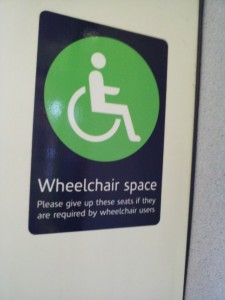 After an hour at the pub next door we came back and arranged a ramp to get on the train, then went up to the platform. Then the train we were getting was delayed, repeatedly. It eventually turned up twenty minutes later than expected and crowds of passengers rushed on to it. I began to panic again because there was no ramp in sight but eventually someone turned up and let me on to the train. We tried to get to the wheelchair space but someone was sitting in it, staring at us. I commented to Karen at least twice and quite loudly that I had to go in the official wheelchair space, and the guy carried on sitting there staring at us. Eventually I directly told him to move and he got up and wandered off, seemingly in a world of his own.
After an hour at the pub next door we came back and arranged a ramp to get on the train, then went up to the platform. Then the train we were getting was delayed, repeatedly. It eventually turned up twenty minutes later than expected and crowds of passengers rushed on to it. I began to panic again because there was no ramp in sight but eventually someone turned up and let me on to the train. We tried to get to the wheelchair space but someone was sitting in it, staring at us. I commented to Karen at least twice and quite loudly that I had to go in the official wheelchair space, and the guy carried on sitting there staring at us. Eventually I directly told him to move and he got up and wandered off, seemingly in a world of his own.
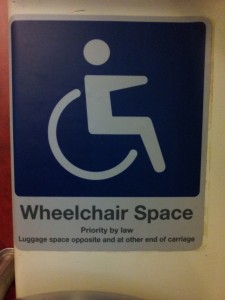 For a while it looked like we would catch a reasonable connection from Birmingham to Manchester but as the journey continued our train got more and more delayed, arriving at Birmingham about ten minutes after our connection. We made our way to the right platform and someone turned up to help us but it was 5pm and the platform was crammed full. When the train arrived it was even worse; it was already standing room only and when we passed the window next to the wheelchair space we could see that it was completely filled with luggage. The lady with the ramp managed to get the space cleared and came back to let us on, but then the corridor had filled up with people too. We shouted at people until they let us through and got to the wheelchair space only to find it full of luggage again. We shoved luggage out of the way and I managed to squeeze into the space, but the wrong way around and with my feet in the way of the door. By this time my blood sugar was low because in all the chaos I hadn’t eaten lunch. Karen went to fetch me a sandwich from the other end of the train. It took her ages because the train was crammed full of passengers standing in the aisles, and she had to wait for other people to leave the train before she could get through. After an hour or so enough people left that Karen found a seat and I was able to throw more cases out of my space so that I could turn around and get my feet out of the way.
For a while it looked like we would catch a reasonable connection from Birmingham to Manchester but as the journey continued our train got more and more delayed, arriving at Birmingham about ten minutes after our connection. We made our way to the right platform and someone turned up to help us but it was 5pm and the platform was crammed full. When the train arrived it was even worse; it was already standing room only and when we passed the window next to the wheelchair space we could see that it was completely filled with luggage. The lady with the ramp managed to get the space cleared and came back to let us on, but then the corridor had filled up with people too. We shouted at people until they let us through and got to the wheelchair space only to find it full of luggage again. We shoved luggage out of the way and I managed to squeeze into the space, but the wrong way around and with my feet in the way of the door. By this time my blood sugar was low because in all the chaos I hadn’t eaten lunch. Karen went to fetch me a sandwich from the other end of the train. It took her ages because the train was crammed full of passengers standing in the aisles, and she had to wait for other people to leave the train before she could get through. After an hour or so enough people left that Karen found a seat and I was able to throw more cases out of my space so that I could turn around and get my feet out of the way.
We did eventually get to Manchester, and only three hours later than we expected and only an hour late to meet our friends at the pub. It doesn’t end there though. On the Sunday night after the conference we wanted to catch a train from Manchester Picadilly to St Helens. Unfortunately at weekends there are no trains on that route, only a replacement bus service. That bus runs from Manchester Oxford Road but we couldn’t get the train from Picadilly to Oxford Road because Oxford Road is completely impossible to get out of in a wheelchair. It turns out that Oxford Road wasn’t too long a walk though, so Karen pushed me there, carrying our luggage too. We were able to fold up my wheelchair and put it in the boot while we were on the coach but if I had been in my power wheelchair then they would have had to get me a taxi instead.
Then finally in St Helens on Tuesday we wanted to catch a bus to meet someone. The bus turned out to be an old one which not only didn’t have a ramp, it also had a bar dividing the front entrance in half which meant that the wheelchair would only fit on by being folded up first. I would have been completely stuck if I had been on my own or in my power wheelchair.
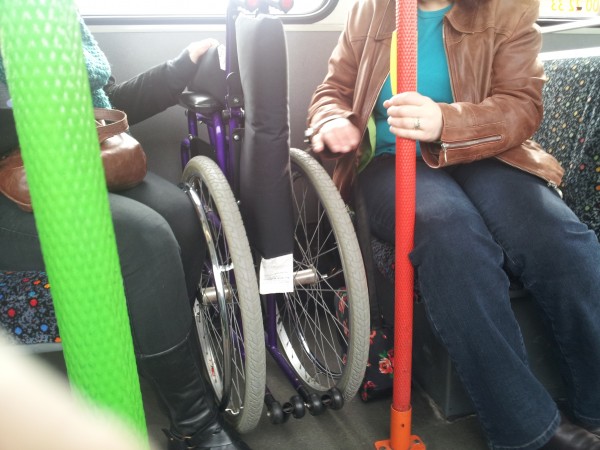
Before I finish, here’s an extract from a previous blog post, the end of Invisible Invincible: my day of protest:
When we went to find our pre-booked assistance for boarding half an hour before the train was due to leave the manager told us that Evesham station was unmanned after lunchtime, which we already knew, but he also didn’t think there would be any staff on the train who could place the wheelchair ramp for me instead of station staff. This caused me to panic a bit but the station manager called another manager who called the train driver who thought there might be staff on board after all. I went to board the train, which is where we discovered that the train did not have a wheelchair space at all. I eventually ended up blocking the door area with my wheelchair for the whole journey. I am quite surprised that the assistance booking line were not aware of the situation with the station staff, the train staff or the type of train.
Unfortunately when we arrived the ticket inspector could not unlock the ramp at the station. She had been given the code for the lock but it did not work. My family had come to meet me at the station to drive us home and so I was carried off the train into a manual wheelchair by my brother, mother and wife, apparently dropped near the edge of the platform on the way. (I wasn’t really conscious, being too exhausted.) They also carried my extremely heavy powerchair off the train. Between them my brother and my wife got me into the car and then from the car to my bed, although I was almost completely unable to move.
I know all of that was a long tedious read but I felt it important to write down. These events are not uncommon, they happen to lots of people all the time. Accessibility should be simple and straightforward but we still have a very long way to go.

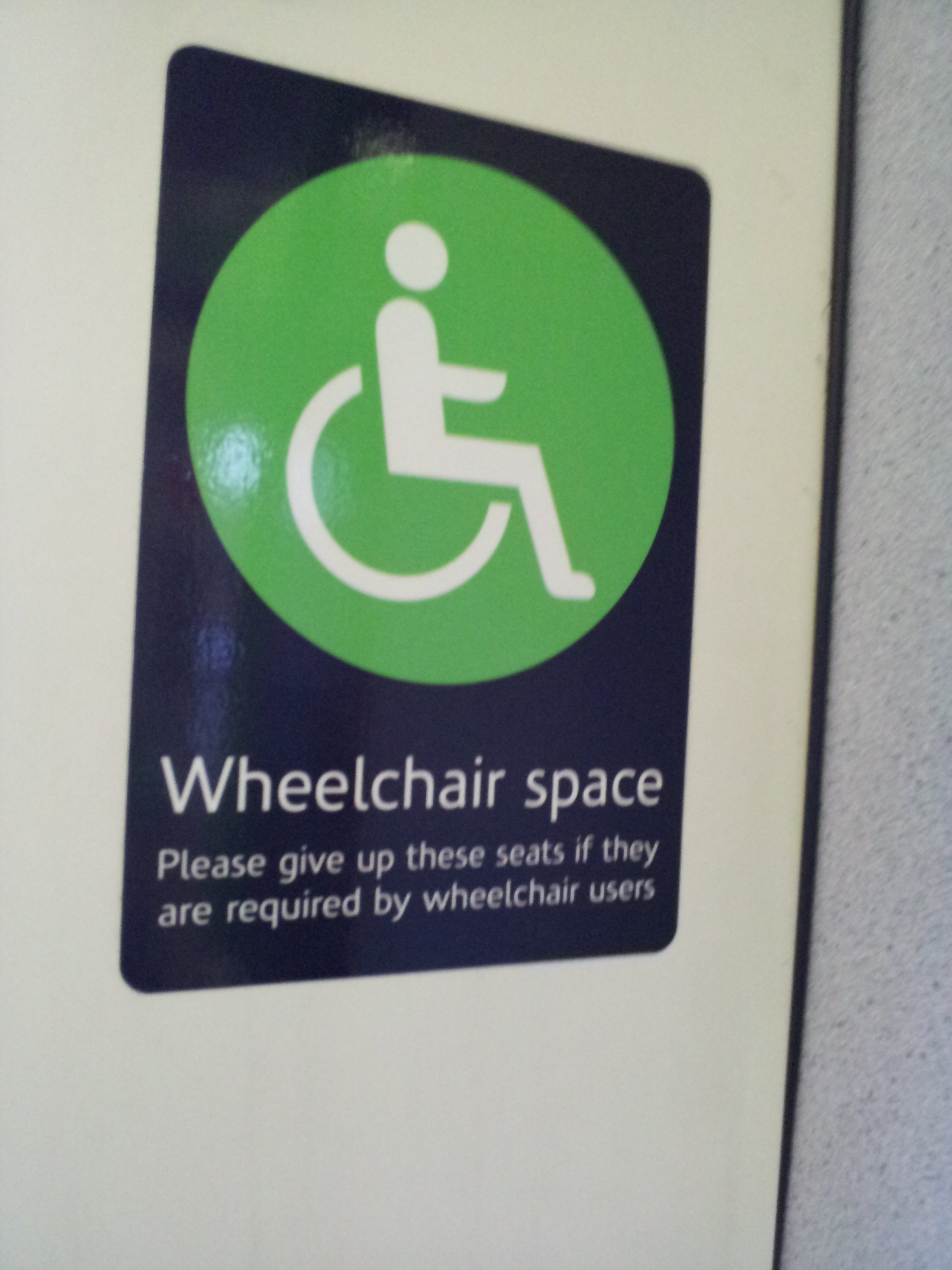
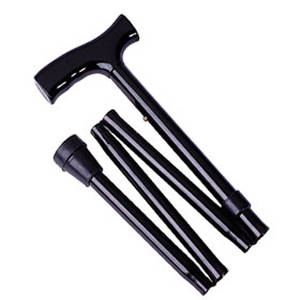
 Sometimes I have to use a walking stick. I walk with a stick because sometimes the pain is too much to put weight on my legs, or my muscles are too weak to hold me up, or I am too dizzy and lack the balance to remain upright. I especially need the stick when I am standing still as without it I can fall over due to all of the above.
Sometimes I have to use a walking stick. I walk with a stick because sometimes the pain is too much to put weight on my legs, or my muscles are too weak to hold me up, or I am too dizzy and lack the balance to remain upright. I especially need the stick when I am standing still as without it I can fall over due to all of the above.